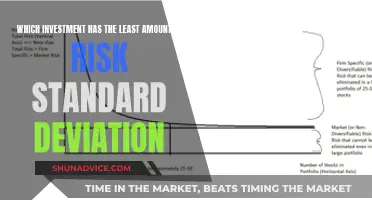
Stress-testing your investment portfolio is a way to predict how your investments will perform in a crisis. It's a way to assess your portfolio's ability to withstand a sharp market downturn and avoid steep losses. This can be done by checking your asset mix, considering your sector exposure, looking at liquidity, and keeping costs to a minimum. By stress-testing your portfolio, you can identify potential trouble spots and make any necessary adjustments to ensure your investments align with your risk tolerance and financial goals. It's recommended to stress-test your portfolio regularly, such as quarterly or semi-annually, to ensure it remains resilient to market changes.
| Characteristics | Values |
|---|---|
| Asset Allocation | The allocation between stocks and bonds affects returns and risk. |
| Costs | Even small increases in cost can erode a significant portion of a portfolio over time. |
| Tax Efficiency | Taking full advantage of tax-efficient accounts such as 401k, 403b, and IRA retirement accounts is critical for long-term growth. |
| Risk Tolerance | Ensure your investments match your tolerance for risk. |
| Volatility | Assess your portfolio's ability to withstand sharp market downturns. |
What You'll Learn

Check your asset mix
Checking your asset mix is a crucial component of stress-testing your investment portfolio. Here are some detailed insights and instructions to help you navigate this process effectively:
Understanding Asset Allocation
The allocation of stocks and bonds in your portfolio significantly impacts returns and risk. As the proportion of equities in a portfolio increases, so do volatility and potential returns. Vanguard's Framework for Constructing Diversified Portfolios illustrates this relationship, highlighting the importance of evaluating your portfolio's risk and your tolerance for that risk. It's essential to consider both the potential loss given your asset allocation and the likelihood of achieving your financial goals with the expected real returns.
Historical Performance Analysis
Analyzing the performance of your portfolio during past bear markets can provide valuable insights. For example, an aggressive portfolio with 80% stocks and 20% Treasury bonds lost nearly 24% during the market declines in 1974, 2002, and 2008. In contrast, a more balanced portfolio with 60% stocks and 40% Treasuries only fell by about 13% on average during those periods, as indicated by Yung-Yu Ma, chief investment strategist for BMO Wealth Management. Considering such historical data can help you assess the resilience of your asset mix.
Diversification and Sector Exposure
Diversifying your portfolio across various sectors can enhance its stability. While technology stocks can offer significant upside potential, they tend to be more volatile and hazardous during market downturns. In contrast, sectors such as consumer staples, healthcare, and utilities have traditionally been less volatile and performed better during challenging market conditions. Ensure your portfolio's sector allocation doesn't deviate dramatically from well-diversified indices like the S&P 500 or the MSCI World Stock Index.
The Role of Treasury Bonds and REITs
While Treasury bonds provided ballast to investment portfolios during the 2002 and 2008 market downturns, their diversification benefits may be reduced in the next market decline due to the current interest rate environment. On the other hand, adding real estate investment trusts (REITs) to your mix of stock and bond holdings can provide greater stability in a bear market. REITs often exhibit low correlation with other equities, moving in a different direction when other equities zig.
Tax Efficiency and Cost Management
Minimizing taxes and managing costs are essential components of stress-testing your portfolio. Take advantage of tax-efficient accounts like 401(k), 403(b), and IRA retirement accounts to defer taxes on contributions and earnings. Additionally, ensure that investments generating significant interest and dividends are held in these tax-advantaged accounts. When it comes to costs, aim for a weighted expense ratio of no more than 0.25% for a portfolio of low-cost index funds and no higher than 0.50% for actively managed funds. Keeping expenses low helps maximize your portfolio's long-term returns.
By carefully considering these factors and regularly evaluating your asset mix, you can enhance the resilience of your investment portfolio and improve your ability to weather various market scenarios.
Emergency Savings: Invest or Keep?
You may want to see also

Consider your sector exposure
Stress testing your investment portfolio is a great way to assess your portfolio's ability to withstand a sharp market downturn. It is important to consider your sector exposure when stress-testing your portfolio. Here are some key points to keep in mind:
Firstly, understand that certain sectors perform better than others during challenging market conditions. For example, during a market downturn between 2015 and 2016, technology stocks declined by 20%, while consumer staples only fell by 9%. This illustrates that companies in certain sectors, like technology, are more volatile and therefore present greater risks during a market decline.
To effectively stress-test your portfolio by sector, compare your portfolio's sector allocation to that of a relevant index, such as the S&P 500 or the MSCI World Stock Index. Ensure that your portfolio's sector allocations do not deviate drastically from the index's allocations. For instance, if the S&P 500 has an allocation of 25% in technology stocks, and you have allocated 50% of your portfolio to this sector, you may be taking on a significant amount of risk.
While it is important to diversify across different sectors, consider tilting your investments towards sectors that have traditionally been less volatile and performed better during difficult markets. These sectors include consumer staples, healthcare, and utilities. Aim for a sector allocation of 5-10% to avoid having too much exposure to any one sector.
Additionally, keep in mind that historical performance is not always indicative of future results. The performance of different sectors can vary depending on the specific economic conditions and other factors. Therefore, it is crucial to regularly review and adjust your portfolio allocations as needed.
By following these guidelines and staying informed about market trends, you can make more informed investment decisions and better manage your risk exposure.
Solow Model: Investment Savings Strategy for Long-Term Growth
You may want to see also

Look at liquidity
Liquidity is a key consideration when stress-testing your investment portfolio. It refers to how easily you can access your money in an emergency. Here are some detailed and instructive guidelines on how to "look at liquidity" when stress-testing:
Understand the Importance of Liquidity
Liquidity is a critical factor in investment portfolio stress testing. It refers to the ability to quickly convert assets into cash without incurring significant losses or penalties. This is especially important in a bear market, where recessions and layoffs may lead to unexpected financial needs.
Assess Your Liquidity Needs
Evaluate how much money you would need to access in a short period during an emergency. Doug Andrew, founder of Live Abundant, recommends keeping at least six months' worth of income in liquid assets. These are assets that can be easily and quickly converted to cash, preferably within seven days or even 24 hours.
Prioritize Liquidity
When building your investment portfolio, prioritize liquidity by placing it at the top of your list. Andrew suggests maintaining high liquidity for all assets, including real estate equity. This ensures that you can access your funds promptly when needed.
Choose Liquid Investments
Select investments that offer high liquidity. For example, consider short-term bond funds or money market funds, which invest in high-quality, short-term securities with good returns and stable values. These investments provide easy access to your funds without the penalties associated with early withdrawals from longer-term investments.
Work with a Financial Advisor
Consult a financial advisor to explore liquid investment options that align with your risk tolerance and financial goals. They can guide you toward investments that meet your liquidity needs while also considering other aspects of your financial plan.
Regularly Review Your Liquidity
Stress-testing your portfolio for liquidity should be an ongoing practice. Review your liquidity needs and the liquidity of your investments at regular intervals, such as quarterly or semi-annually. This ensures that you are prepared for unexpected financial events and can make adjustments as your circumstances change.
Building a Diverse Investment Portfolio: Wages and Strategies
You may want to see also

Keep costs to a minimum
Keeping costs to a minimum is one of the three key components within an investor's control when stress-testing their portfolio. Even small increases in cost, when multiplied over a lifetime of investing, can erode a significant portion of a portfolio. For example, a $100,000 portfolio that earns a 6% return and incurs 0.25% in expenses will result in a balance of about $530,000 at the end of 30 years. However, if the expenses are increased to 0.90%, the ending balance drops by nearly $100,000 to about $438,000.
To keep costs to a minimum, investors should ensure their portfolio's expenses are reduced to a minimum. A portfolio of low-cost index funds should aim for a weighted expense ratio of no more than 0.25%. With some actively managed funds, the ratio should not exceed 0.50%. Anything above these levels warrants close scrutiny.
Most actively managed mutual funds have higher expense ratios than index or passive funds. In 2016, the average expense ratio for actively managed funds was 0.82%, down from 1.08% in 1996. A low-cost portfolio should aim for expense ratios of less than 0.25% for passive funds and no more than 0.8% for actively managed funds.
When the market falls, funds with high expense ratios only compound those losses. Therefore, it is essential to assess the costs of all holdings and substitute lower-cost alternatives for any funds that are too expensive.
Monthly or Annually: Which Investing Strategy Wins?
You may want to see also

Minimise taxes
Minimising taxes is a crucial component of stress-testing your investment portfolio. Here are some strategies to reduce your tax burden:
- Prioritise long-term capital gains: Long-term capital gains, where you hold an asset for at least a year, are typically taxed at a lower rate than short-term capital gains. This strategy can result in substantial tax savings.
- Consider a buy-and-hold strategy: Since capital gains taxes are only incurred when an asset is sold, adopting a buy-and-hold strategy can significantly reduce your tax bill over time.
- Choose passive funds (index funds and ETFs): Passive funds, such as ETFs and index funds, tend to generate fewer taxable events, especially capital gains, as they don't trade frequently. This results in lower tax liability.
- Earn qualified dividends: Qualified dividends are taxed at a lower rate than ordinary dividends. To be considered qualified, ensure you meet the IRS requirements, such as holding the stock for a specific duration.
- Choose tax-efficient bonds: Municipal bonds, Series I bonds, and Treasury bonds offer tax advantages. Municipal bonds are typically exempt from federal, state, and local taxes. Series I bonds and Treasury bonds are exempt from state and local taxes but subject to federal taxes.
- Optimise asset allocation for tax efficiency: Place tax-efficient assets, such as index funds, ETFs, qualified dividends, and tax-efficient bonds, in taxable investment accounts. Conversely, place tax-inefficient assets, such as mutual funds, actively managed ETFs, and REITs, in tax-advantaged accounts like 401(k)s and IRAs.
- Consider a charitable trust: Donating appreciated securities, such as stocks, bonds, or funds, to a charitable trust allows you to avoid paying capital gains tax and provides a tax deduction for the donation.
- Use tax-loss harvesting: The IRS allows you to offset realised investment losses against your gains, reducing your overall tax liability. You can also carry forward net losses to future tax years if they exceed the allowable amount.
- Contribute to a 401(k) or IRA: These tax-advantaged accounts allow you to defer taxes on contributions and earnings, helping your nest egg grow faster. A Roth IRA or Roth 401(k) offers the additional benefit of tax-free withdrawals in retirement.
Savings and Investment: Finding Equilibrium Balance
You may want to see also
Frequently asked questions
Stress testing your portfolio can help identify potential trouble spots, such as overweighting a particular stock or sector. It can also help you determine how your portfolio would fare in a bear market.
Robert Nevarez, a financial advisor and partner at HN Financial Group, recommends investors test their portfolios quarterly or semi-annually.
The three key components within your control are asset allocation, costs, and tax efficiency.
The allocation between stocks and bonds affects returns and risk more than any other asset allocation decision. Portfolios with a heavier weighting of stocks don't hold up as well in a bear market.
Even small increases in cost, multiplied over a lifetime of investing, can erode a significant portion of a portfolio. For example, a $100,000 portfolio that earns a 6% return and incurs 0.25% in expenses will result in a balance of about $530,000 at the end of 30 years.







